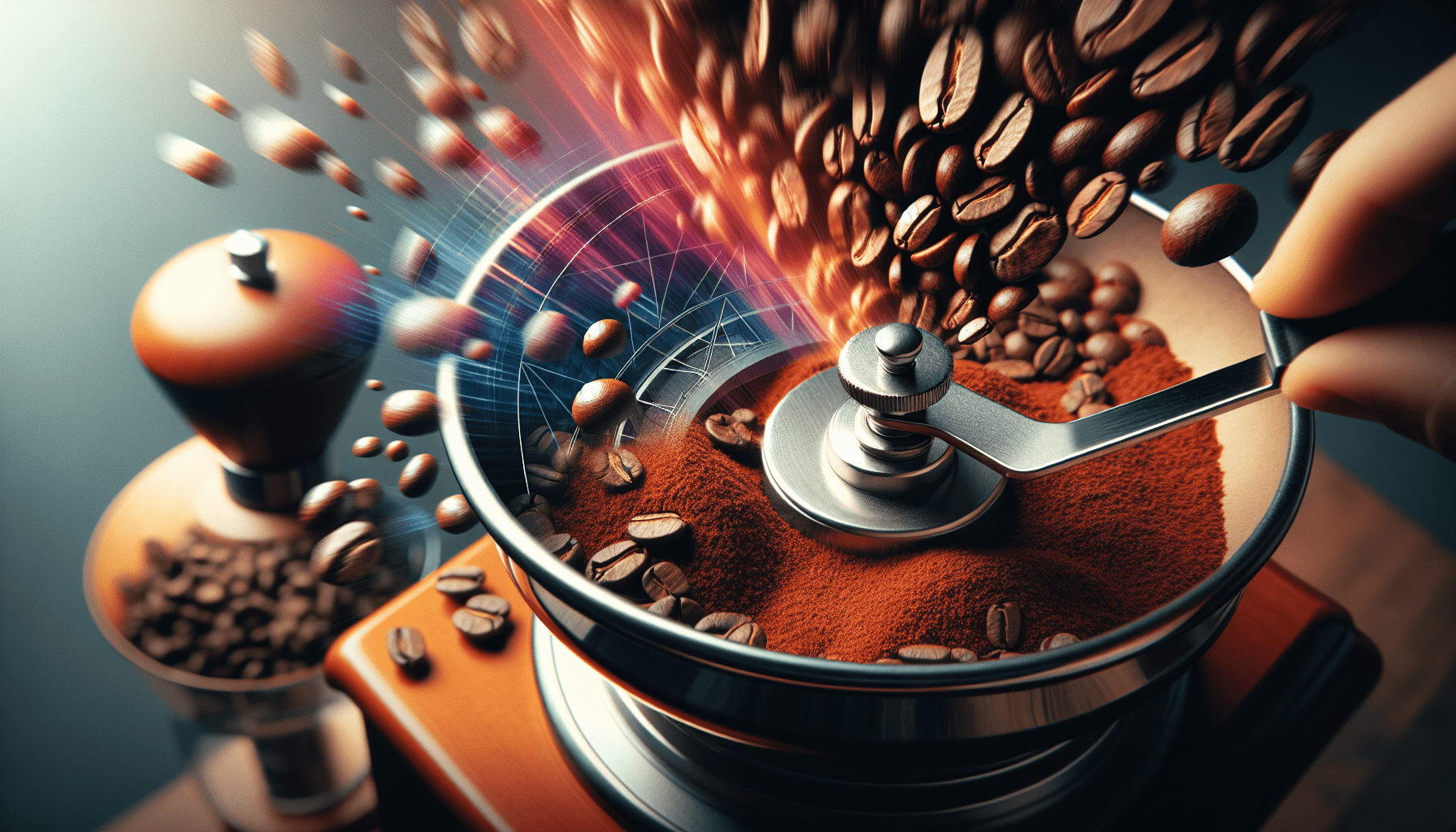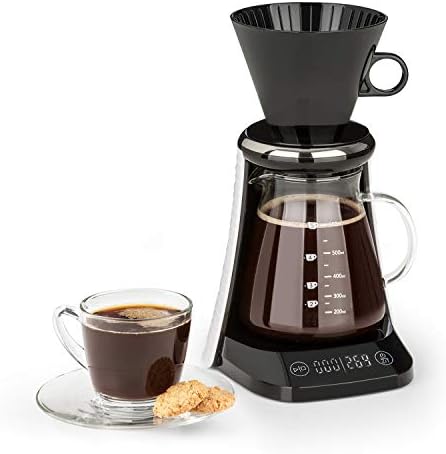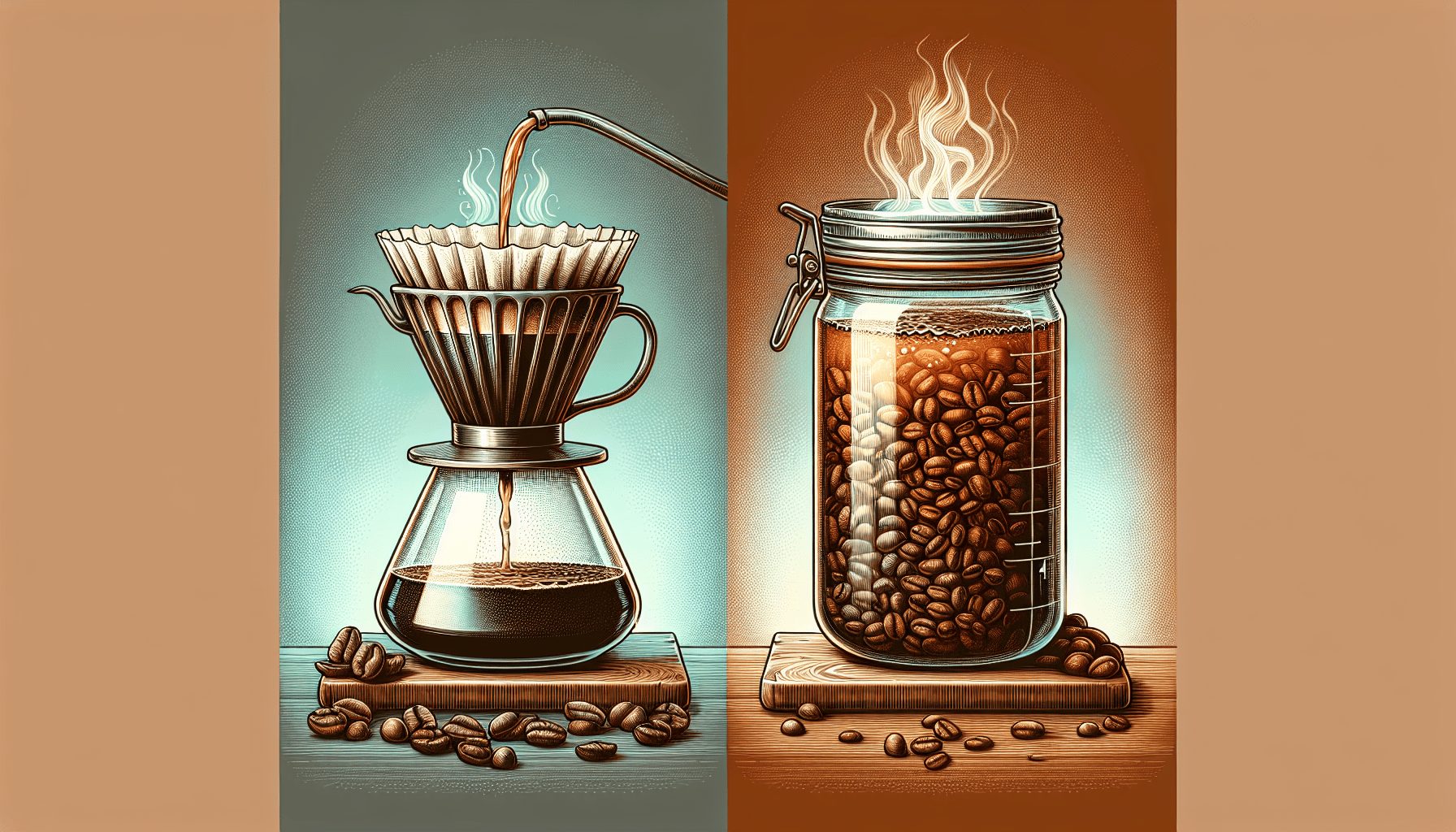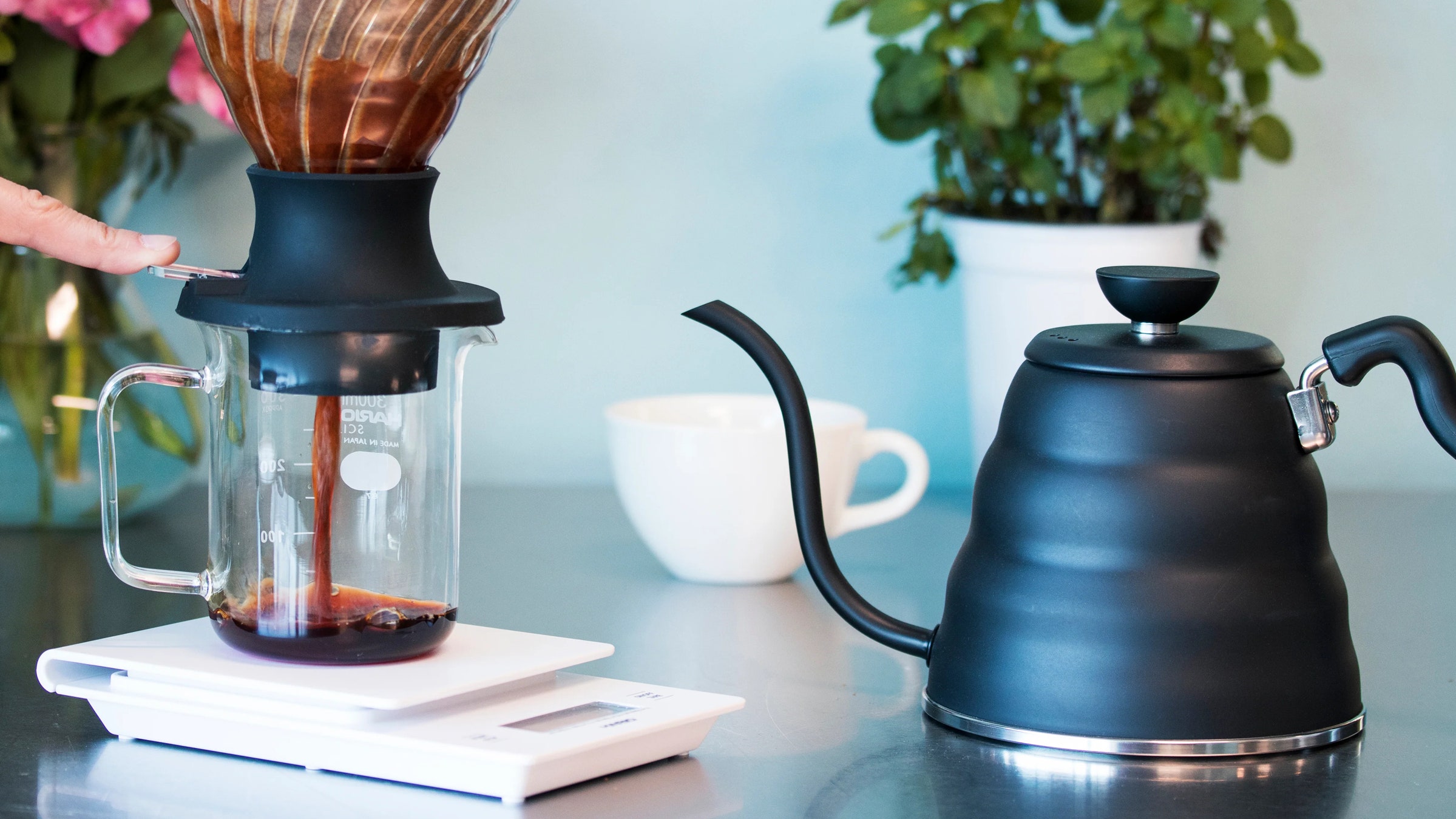You love the rich, flavorful aroma of freshly brewed coffee, and you have recently invested in a pour-over coffee maker to elevate your morning coffee experience. But now you find yourself faced with a question: what type of coffee grind is best for a pour-over coffee maker? The answer lies in finding the perfect balance between coarseness and finesse, ensuring that every cup you pour is an exquisite blend of taste and aroma. So, let’s explore the different coffee grind options and discover the one that will take your pour-over coffee to new heights of perfection.
Course Grind
Definition
A coarse grind refers to coffee beans that have been ground into large, uneven particles. This type of grind has a chunky texture, similar to sea salt or coarse sand. It is ideal for use in a pour-over coffee maker when you want a bold and flavorful cup of coffee.
Benefits
One of the main benefits of using a coarse grind in a pour-over coffee maker is that it allows for a slower and more controlled extraction process. The large particles of coffee require more time for water to pass through, resulting in a longer contact time and a stronger brew. This helps to enhance the flavor and aroma of the coffee, resulting in a rich and robust cup.
Additionally, a coarse grind can help prevent over-extraction, which can lead to a bitter and unpleasant taste. The slower extraction process allows for the natural flavors of the coffee to be fully extracted without releasing too much bitterness or acidity. This makes it a great choice for those who prefer a smoother and less acidic coffee.
Drawbacks
While a coarse grind offers many benefits, it does have a few drawbacks. One of the main drawbacks is that the large particles can sometimes result in an inconsistent brew. Since the water has to pass through the gaps between the particles, it can create channels that allow water to flow through more quickly, leading to uneven extraction.
Another drawback is that a coarse grind may not work as well with certain types of pour-over coffee makers. Some pour-over devices, such as the Hario V60, require a finer grind size to achieve the desired brewing time and extraction. Therefore, it’s important to consider the specific pour-over method you will be using when choosing your grind size.
Medium Grind
Definition
A medium grind refers to coffee beans that have been ground into uniform particles that are slightly smaller than those of a coarse grind. It has a texture similar to sand, with particles that are large enough to be easily distinguishable, but not as chunky as a coarse grind.
Benefits
Using a medium grind in a pour-over coffee maker offers a balance of extraction and flavor. The smaller particle size allows water to pass through more quickly than a coarse grind, resulting in a shorter contact time and a slightly lighter brew. This makes it a great option for those who prefer a milder and more balanced cup of coffee.
Additionally, a medium grind can be more forgiving in terms of extraction. It is less prone to channels forming, which can lead to an uneven brew. This makes it a more reliable choice for beginners who may not have mastered the pouring technique yet.
Drawbacks
One drawback of using a medium grind is that it may not achieve the same level of flavor intensity as a coarse grind. Since the particles are smaller, the water has less time to extract the flavors, resulting in a slightly less robust cup of coffee. However, for those who prefer a milder taste, this may not be a drawback at all.
Another drawback is that the medium grind may not work as well with pour-over methods that require a precise brewing time and extraction, such as the Chemex. It’s important to consider the specific pour-over device you will be using and adjust your grind size accordingly.
Fine Grind
Definition
A fine grind refers to coffee beans that have been ground into small, uniform particles that are similar in size to granulated sugar. It has a smooth and powdery texture, making it ideal for certain pour-over coffee makers.
Benefits
Using a fine grind in a pour-over coffee maker allows for a quicker extraction process and a more delicate cup of coffee. The smaller particles provide a larger surface area for water to come into contact with, resulting in a faster extraction. This can be beneficial for those who prefer a brighter and more acidic cup of coffee.
Additionally, a fine grind is well-suited for pour-over methods that rely on a shorter brewing time, such as the AeroPress. The quick extraction allows for a more precise control over the flavors and acidity of the coffee, resulting in a clean and vibrant cup.
Drawbacks
One drawback of using a fine grind is that it can be more challenging to achieve consistency in the brewing process. The smaller particles can easily create channels that allow water to flow through more quickly, leading to an uneven extraction. This can result in a cup of coffee that is either too weak or too strong in flavor.
Another drawback is that a fine grind is prone to over-extraction. If the brewing time is not carefully controlled, the fine particles can release too much bitterness and acidity, resulting in an unpleasant taste. It’s important to pay close attention to the brewing time and adjust it accordingly when using a fine grind.
Extra Fine Grind
Definition
An extra fine grind refers to coffee beans that have been ground into incredibly tiny particles, similar to powdered sugar. It is the finest grind size available and is typically used for specialized coffee brewing methods.
Benefits
The main benefit of using an extra fine grind is that it allows for an incredibly quick extraction process. The small particles provide an extensive surface area for water to interact with, resulting in an almost immediate extraction of flavors. This is ideal for brewing methods that require a short brewing time, such as espresso or Turkish coffee.
Additionally, the extra fine grind size can help create a more intense and concentrated cup of coffee. The quick extraction and high surface area allow for a greater extraction of flavors, resulting in a stronger and bolder brew.
Drawbacks
One drawback of using an extra fine grind is that it can be challenging to achieve consistency in the brewing process. The small particles are more prone to compacting, creating a dense bed of coffee that can slow down the water flow and lead to uneven extraction. This can result in a cup of coffee that is either too weak or too strong in flavor.
Another drawback is that an extra fine grind may not work well with pour-over coffee makers that have a filter with larger holes. Since the grind is so fine, it can pass through the filter and end up in the cup, resulting in a gritty texture. It’s important to consider the specific pour-over method and filter you will be using when choosing your grind size.
Coarse Grind
Definition
A coarse grind refers to coffee beans that have been ground into large, uneven particles. This type of grind has a chunky texture, similar to sea salt or coarse sand. It is ideal for use in a pour-over coffee maker when you want a bold and flavorful cup of coffee.
Benefits
One of the main benefits of using a coarse grind in a pour-over coffee maker is that it allows for a slower and more controlled extraction process. The large particles of coffee require more time for water to pass through, resulting in a longer contact time and a stronger brew. This helps to enhance the flavor and aroma of the coffee, resulting in a rich and robust cup.
Additionally, a coarse grind can help prevent over-extraction, which can lead to a bitter and unpleasant taste. The slower extraction process allows for the natural flavors of the coffee to be fully extracted without releasing too much bitterness or acidity. This makes it a great choice for those who prefer a smoother and less acidic coffee.
Drawbacks
While a coarse grind offers many benefits, it does have a few drawbacks. One of the main drawbacks is that the large particles can sometimes result in an inconsistent brew. Since the water has to pass through the gaps between the particles, it can create channels that allow water to flow through more quickly, leading to uneven extraction.
Another drawback is that a coarse grind may not work as well with certain types of pour-over coffee makers. Some pour-over devices, such as the Hario V60, require a finer grind size to achieve the desired brewing time and extraction. Therefore, it’s important to consider the specific pour-over method you will be using when choosing your grind size.
Specialty Grind
Definition
A specialty grind refers to coffee beans that have been ground to a specific size to suit a particular brewing method. This type of grind is typically used by coffee enthusiasts who are looking to achieve the best possible flavors and extraction.
Benefits
Using a specialty grind in a pour-over coffee maker allows for the perfect balance of extraction and flavor. The grind size is specifically tailored to the characteristics of the pour-over device and the desired brewing time, resulting in a cup of coffee that maximizes the flavors and aromas of the beans.
Additionally, a specialty grind can provide a greater level of precision and control over the brewing process. The carefully selected grind size ensures a consistent extraction, reducing the risk of over or under-extraction. This makes it a great choice for those who are serious about their coffee and want to achieve the best possible results.
Drawbacks
One of the drawbacks of using a specialty grind is that it may be more difficult to find or create. Specialty grinds are often specific to certain brewing methods, and may not be readily available at all coffee shops or grocery stores. This may require the coffee enthusiast to invest in their own grinder and experiment with different grind settings to find their preferred size.
Another drawback is that the precision required for a specialty grind can be more time-consuming and challenging for beginners. It may take some trial and error to achieve the desired results, and the process can be less forgiving than using a more standard grind size.
Grind Consistency
Importance
The consistency of the coffee grind is crucial to the pour-over brewing process. A consistent grind size ensures that each coffee particle is exposed to an equal amount of water during extraction, resulting in a balanced and flavorful cup of coffee. Inconsistent grind sizes can lead to over-extraction of some particles and under-extraction of others, resulting in a cup of coffee that is either too weak or too strong in flavor.
Factors to consider
There are several factors to consider when it comes to grind consistency. The first is the type of grinder being used. Burr grinders are generally considered to be the best option for achieving a consistent grind, as they grind the coffee beans between two abrasive surfaces. This helps to ensure that each particle is ground to a uniform size.
Blade grinders, on the other hand, tend to produce a less consistent grind. The blades spin at high speeds, chopping the coffee beans into different-sized particles. This can result in a mix of fine and coarse grounds, leading to an uneven extraction.
Another factor to consider is the grinding method. Manual grinding, while more time-consuming, allows for greater control over the grind size and can result in a more consistent grind. Electric grinding, on the other hand, is quicker and more convenient, but may result in a less consistent grind.
The quality and freshness of the coffee beans can also impact grind consistency. Older beans tend to be more brittle and can produce more inconsistent grounds. It’s important to use freshly roasted beans and store them properly to ensure the best possible grind consistency.
Grinders and Grinding Methods
Burr Grinder vs Blade Grinder
When it comes to choosing a grinder for your pour-over coffee, there are two main options to consider: burr grinders and blade grinders.
Burr grinders are generally considered to be the superior option for achieving a consistent grind. These grinders operate by crushing the coffee beans between two abrasive surfaces, resulting in a more uniform particle size. Burr grinders offer greater control over the grind size and are commonly available in both manual and electric options.
Blade grinders, on the other hand, operate by spinning a set of blades at high speeds, chopping the coffee beans into different-sized particles. While blade grinders are generally more affordable and convenient, they tend to produce a less consistent grind. The blades can create a mix of fine and coarse grounds, leading to an uneven extraction and potentially affecting the overall flavor of the coffee.
If you are serious about achieving the best possible pour-over coffee, investing in a burr grinder is highly recommended. The consistency of the grind will greatly impact the extraction process and the resulting flavor of your coffee.
Manual Grinding vs Electric Grinding
When it comes to grinding your coffee beans for a pour-over, you have the option of manual grinding or electric grinding.
Manual grinding involves using a hand-operated grinder, such as a hand grinder or a manual burr grinder. This method offers greater control over the grind size and allows for a more precise and consistent grind. It also allows you to enjoy the process of grinding your own beans and can be a more meditative and enjoyable experience for coffee enthusiasts.
Electric grinding, on the other hand, involves using an electric grinder to quickly and conveniently grind your coffee beans. Electric grinders are typically faster and require less effort compared to manual grinders. They are a popular choice for those who value efficiency and convenience in their coffee brewing routine.
Both manual and electric grinding methods can produce a consistent grind, depending on the quality of the grinder and the technique used. It ultimately comes down to personal preference and the level of control and involvement you desire in the coffee brewing process.
Choosing the Right Grind Size
Pour-over Coffee Variables
When choosing the right grind size for pour-over coffee, there are several variables to consider. These variables include the type of pour-over device being used, the desired brewing time, and personal taste preferences.
Different pour-over devices, such as the Hario V60, Chemex, or AeroPress, may require slightly different grind sizes for optimal extraction. It’s important to refer to the manufacturer’s guidelines or experiment to find the best grind size for your specific device.
The desired brewing time is another factor to consider. Generally, a finer grind size will result in a quicker brewing time, while a coarser grind size will require a longer brewing time. It may be helpful to start with a recommended grind size, such as medium, and adjust from there based on the desired brewing time.
Lastly, personal taste preferences play a significant role in choosing the right grind size. Some individuals prefer a milder and less intense brew, while others enjoy a bolder and more robust cup of coffee. Experimenting with different grind sizes can help you find the perfect balance of flavor and strength that suits your taste.
Experimentation and Preferences
Finding the perfect grind size for your pour-over coffee may require some experimentation and trial and error. It’s important to remember that personal preferences can vary greatly, and what works for one person may not work for another.
Start by following the manufacturer’s guidelines for your specific pour-over device. This will provide a good starting point for the grind size. From there, make small adjustments to the grind size and observe the changes in flavor and brewing time.
If the coffee tastes weak or sour, try using a finer grind size to increase the extraction. On the other hand, if the coffee tastes bitter or over-extracted, try using a coarser grind size to shorten the brewing time. Keep experimenting until you find the ideal grind size that produces a cup of coffee that satisfies your taste preferences.
Remember, finding the perfect grind size is a journey of exploration and discovery. Embrace the process and enjoy the opportunity to fine-tune your pour-over brewing technique to achieve the best possible cup of coffee.
Tips for Achieving the Best Pour-over
Water Temperature
The temperature of the water plays a crucial role in achieving the best pour-over coffee. Ideally, the water should be between 195°F and 205°F (90°C and 96°C) when it makes contact with the coffee grounds.
Water that is too hot can lead to over-extraction, resulting in a bitter and unpleasant taste. On the other hand, water that is too cool can result in under-extraction, leaving the coffee weak and lacking in flavor.
To ensure the proper water temperature, bring the water to a boil and then allow it to cool slightly before pouring it over the coffee grounds. Using a kettle with a gooseneck spout can provide more control and precision when pouring, allowing for an even extraction.
Brew Time
The brew time is another critical factor in achieving the best pour-over coffee. The optimal brew time can vary depending on the grind size, pour-over device, and personal taste preferences.
As a general guideline, a medium grind size typically requires a brew time of around 3-4 minutes. Finer grind sizes may require a slightly shorter brew time, while coarser grind sizes may need a longer brew time.
It’s recommended to experiment with different brew times to find the sweet spot that produces a cup of coffee with the desired strength and flavor. Start with the recommended brew time for your specific pour-over device and adjust from there based on your personal preferences.
Brew Ratio
The brew ratio refers to the amount of coffee grounds used in relation to the amount of water. It plays a significant role in determining the strength and flavor profile of the pour-over coffee.
A commonly recommended brew ratio is 1:16, which means using 1 gram of coffee grounds for every 16 grams of water. However, this ratio can be adjusted based on personal taste preferences. For a stronger cup, use a higher coffee-to-water ratio, such as 1:15. For a milder cup, use a lower coffee-to-water ratio, such as 1:17.
It’s important to note that the brew ratio should be measured by weight, rather than volume, for accuracy. Using a kitchen scale to measure the coffee and water will allow for a more precise brew ratio.
Experiment with different brew ratios to find the one that produces a cup of coffee that suits your taste preferences. Remember to adjust the grind size and brew time accordingly when making changes to the brew ratio, as these variables are interconnected.
By paying attention to water temperature, brew time, and brew ratio, you can achieve the best possible pour-over coffee. These tips, along with choosing the appropriate grind size, will help you unlock the full flavors and aromas of your coffee beans and create a truly exceptional cup of coffee. Happy brewing!




